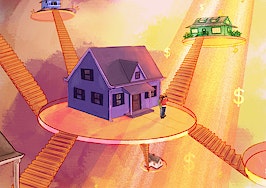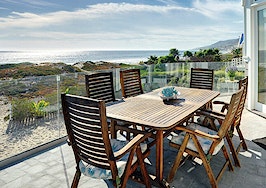If you drive 30 minutes south of Salt Lake City, beyond the state prison but not quite to the NSA data center, you’ll find in the shadow of the world’s largest open-pit mine a sprawling community of brightly colored homes. Daybreak, as the area is called, sits on thousands of acres of land and has been under development for a decade and a half. Construction may yet continue for decades to come.

A row of houses in Daybreak. Credit: Daybreak Communities
Years ago, the land that would eventually become Daybreak was an afterthought, but today Daybreak is a destination. The community is proximate to a booming technology corridor know as the “Silicon Slopes.” There are shops and parks and a light rail line nearby. And the homes are, frankly, lovely; they come in a rainbow of colors and styles, many of which mimic the charming architecture of yore.
But all this beauty and order and New Urbanist flare comes at a cost: Daybreak houses are part of a homeowner’s association (HOA).
For that reason, Daybreak epitomizes the type of new development happening right now in America. According to new data from the U.S. Census Bureau, there were 840,000 single family homes completed in 2018. Of those homes, 64 percent, or about 535,000, were part of an HOA. That compares to only 306,000 new, single-family homes that weren’t part of HOAs.
Census data on the number of homes sold is even more lopsided: Americans bought 472,000 newly constructed HOA homes in 2018, but only 145,000 without HOAs.
Those numbers represent a remarkable trend in U.S. housing. In 2009, just a decade ago, developers finished 279,000 non-HOA homes but only 241,000 homes with HOAs. HOA and non-HOA construction remained roughly comparable for the next several years until, in 2011, it flipped in favor of the homeowner’s associations.
Ever since, new HOA homes have been taking up a larger and larger share of the overall new single-family housing stock.

Census data shows construction of new HOA homes, represented in blue, taking up a greater and greater share of overall new home construction over the last decade. The number of completed non-HOA homes is represented here in red. Credit: U.S. Census Bureau and Jim Dalrymple II
The Census data doesn’t offer explanations for why builders and buyers have both increasingly favored HOA developments over the last decade.
However, University of California, Irvine, economics professor Matthew Freedman — who just co-authored a new study on HOA development — told Inman that there are a number of factors at play. And chief among those factors is that HOAs take some of the financial pressure off of local governments.

Matthew Freedman
“So the local government requires the developers to set up an HOA to maintain roads and parks,” Freedman explained. “For the local government it’s fantastic because they’re not on the hook.”
The idea, in other words, is that it’s expensive to build and maintain things like roads. That’s especially true in low-density communities, where the number of houses may not actually generate enough long-term tax revenue to maintain basic infrastructure. Charles Marohn, an engineer and urban planner, has referred to this problem as a “ponzi scheme” because some suburban communities may never be financially self-sustaining.
HOAs, then, offer a way to sidestep that problem by shifting more of the infrastructure burden to homeowners.
“Its also great for the local government in the longer run because [homeowners in HOA communities] pay property taxes, but the local government doesn’t have to provide all the same sort of goods,” Freedman further explained.

Homes in Daybreak, Utah. Credit: Daybreak Communities
There are other factors as well that have given rise to HOAs. Freedman pointed to the Clean Water Act of 1972, for example, which required communities to manage water runoff. That meant building large spaces to handle water — sometimes you see these today in the form of sunken parks that double as catchment areas — which can be expensive to operate.
“Somebody has to maintain that and there’s a need for some entity, an HOA,” Freedman explained.
And then there’s race. Freedman pointed out that the gradual rise in homeowner’s associations in the U.S. coincided with laws that prevented racial discrimination in housing.
“In the absence of being able to limit who can purchase in communities on the basis of race and other characteristics, these HOAs served as a means of excluding other groups,” Freedman added.
Author and urban theorist Mike Davis charted Los Angeles’ version of this phenomenon in his book City of Quartz, describing HOAs in the early and mid 20th Century as a “white wall” meant to keep minorities out of Caucasian neighborhoods. The region was important for the early evolution of HOAs in the U.S., and Davis reported that the organizations were also used to fight density increases and development generally.
Though the racial components of HOAs may since have faded somewhat over the decades, Freedman said that the ability to control development in a neighborhood remains one of the organizations’ selling points to homeowners.
“The HOAs impose some common zoning-like restrictions on what people can do,” Freedman explained. “It kind of mitigates some potential externalities of your neighbors’ behavior.”
The number of reasons HOAs appeal to developers and consumers could go on, but in any case the Census data makes it clear that the appeal is indeed growing. And Freedman’s own research also reveals that the growth has been many decades in the making.
“There has been a steady increase in the prevalence of HOAs since the 1960s,” Freedman and co-author Wyatt Clarke wrote in their recent paper.
But not every part of the country has seen an equal amount of HOA growth. Freedman and Clarke’s paper shows, in fact, that the growth of HOAs has been most pronounced in states along the southern Atlantic coast, in and around Texas and in the Mountain West. That may have to do with the fact that these regions have more room for new greenfield development than comparatively crowded corridors along the Northeast and Pacific coasts.
“I think a central feature of HOAs these days is that a lot of them appear at the fringes of cities where there’s new development happening,” Freedman added. “Developers who have a large area of land they want to build houses on work out arrangements with local governments.”

Homes under construction in Daybreak. Credit: Daybreak Communities
Daybreak exemplifies several of these trends. It’s located in the Mountain West, for example, and was built from scratch on previously open land at the edge of the Salt Lake metro area. And its growth has coincided with the broader explosion of HOA communities in the U.S.
In an email, Cameron Jackson, a spokesperson for the developers of Daybreak, told Inman that the HOA there has been well received. The association fees are currently $129 per month, which includes a $34 charge for high speed internet. The HOA also provides four pools and fitness centers, 30 parks, more than 40 miles of trails, numerous playgrounds and a 65-acre artificial lake where residents can check out boats for free.
“We believe the HOA is a selling point due to the unique and varied amenities that we provide,” Jackson added, “as well as the great job they do at keeping the community looking great.”

A lake in Daybreak, an HOA community south of Salt Lake City. Credit: Daybreak Communities
But more broadly, are HOAs actually good?
It’s a difficult question to answer, and Freedman said that researchers are generally divided. Many economists, for example, have a somewhat favorable view of HOAs because they see people as acting rationally and ultimately finding some value in HOA communities. However, other researchers have criticized HOAs because they believe that homebuyers don’t fully understand or read the restrictive contracts they include — something Freedman saw first hand when he lived in an HOA community.
Freedman declined to take a side himself, but did note that his research shows HOA homes actually sell for more than non-HOA homes.
“The paper’s overarching conclusion is that single-family houses with an HOA generally sell at a premium, but with substantial local variation,” Freedman and Clarke wrote. “On average, buyers pay at least 4 percent, or $13,500, extra for a house that is subject to an HOA.”
Freedman’s research also shows that homes in HOA communities tend to have a handful of other specific attributes, including sitting on smaller plots of land and being around 400 square feet larger than other homes.
“Homes in HOAs have higher property taxes on average, are more likely to have access to a golf course, and are more likely to be waterfront,” Freedman and Clarke added in their paper.
Freedman also told Inman that it remains to be seen what will happen to HOAs in the future. Though their popularity right now shows no sign of slowing down, some will, inevitably, cease to function. And when that happens, Freedman said, “it’s going to be up to the local governments to decide what to do” about all the responsibilities that the HOAs once assumed.
Only time will tell how that story plays out.
“I don’t think,” Freedman added, “that this is a resolved question.”
How do you stay ahead in a changing market? Inman Connect Las Vegas — featuring 250+ experts from across the industry sharing insight and tactics to navigate threat and seize opportunity in tomorrow’s real estate market. Join more than 4,000 top producers, brokers and industry leaders to network and discover what’s next, July 23-26 at the Aria Resort. Hurry! Tickets are going fast, register today!
Thinking of bringing your team? There are special onsite perks and discounts when you buy tickets together. Contact us to find out more.







